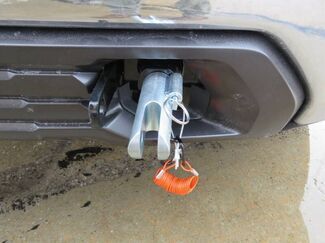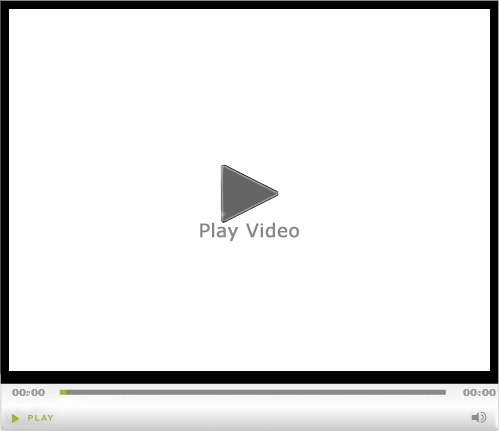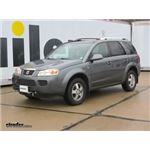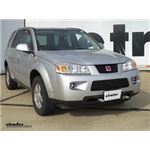Blue Ox Base Plate Kit - Removable Arms
2011 Coachmen Pathfinder Motorhome
Will this fit?
To see if this custom-fit item will work for you please tell us what vehicle you'll use it with.
- All Info
- Reviews (4467)
- Q & A (0)
- Videos (2)
- Photos
Blue Ox Tow Bar Base Plate - BX3335
- Blue Ox
- Removable Draw Bars
- Twist Lock Attachment
- Completely Hidden
Custom designed to fit your vehicle so it can be safely towed behind your RV, this base plate has easily removable arms that offer a seamless look when you're not flat towing. Base plate bolts directly to your chassis, so no welding is required.
Features:
- Custom-fit base plate provides attachment points for your tow bar when flat towing
- Hidden design provides a clean, seamless look
- Arms remove with a simple twist when not in use
- Brackets won't protrude past the front of your vehicle
- Sturdy design spreads towing force evenly to prevent stress on your vehicle's suspension
- Integrated mounting points let you easily attach an electrical connector plug with bracket (sold separately)
- Receiver covers keep dirt and debris out of the base plate when arms are removed and provide a finished look
- Durable steel construction is powder coated to resist rust and corrosion
- Straightforward installation - no welding required
- Base plate bolts securely to your vehicle's chassis with included mounting hardware
- Sturdy lugs pair with Blue Ox tow bars to form a secure and reliable connection
- Adaptable for use with Roadmaster tow bars - adapter (RM-031 or RM-031-5) sold separately
- Adaptable for use with Demco tow bars - adapter (DM9523041) sold separately
- Made in the USA
Specs:
- Distance between brackets: 18"
- Bracket height: 15"
- 3-Year warranty
Simple, Hidden Design


This base plate's hidden design creates a clean and seamless look. The bracket arms are easily removable, creating a slick appearance when you're not flat towing. Because the arms can be removed, you also won't have to worry about banging your leg into any protruding arms when you walk by.

Attaching and removing the bracket arms is a breeze. To attach the arms to the base plate, simply insert them into the receivers and rotate them until they lock into place. Once you're finished towing and want to remove the arms, pull the pin to disengage the lock, rotate the arms, and remove them from the receivers. Finally, plug up the now empty receivers with the included receiver covers to help keep dirt and debris out of the base plate and provide a finished look.
Guide to Flat Towing
Flat towing your vehicle is much more convenient than using a trailer or a tow dolly. These other options take up much more storage space, leaving you less room both at home and at the campsite. In addition, securing your vehicle to a trailer or tow dolly can be a hassle and more time consuming than hooking up with a tow bar.
There are 5 basic components needed when flat towing a vehicle: a tow bar, a base plate kit, a safety cable set, tow bar wiring, and a supplemental braking system.

The tow bar links your towed car to your motorhome. It attaches to the custom-fit base plates that install on the frame of your towed car. Safety cables ensure that your towed car does not separate from your motorhome in the event that your tow bar becomes detached. Tow bar wiring allows your towed vehicle's signal lights to sync up with your motorhome's tail lights, which is required by law in most states. Finally, the supplemental braking system - also required in most states - brakes your towed car when the brakes in your motorhome are activated, preventing wear on the motorhome and decreasing braking distance for your entire setup.
BX3335 Blue Ox Baseplate - Removable Tabs
Installation DetailsThis Product Fits The Following Vehicles
- 2006 - 2007 Saturn Vue 4-cylinder Engine
- 2006 - 2007 Saturn Vue 6-cylinder Engine - excluding Red Line
California residents: click here


Videos are provided as a guide only. Refer to manufacturer installation instructions and specs for complete information.
Video Transcript for Mount: Blue Ox Base Plate Kit on a 2007 Saturn Vue
Today on our 2007 Saturn Vue, we're going to take a look at and show you how to install the Blue Ox Base Plate with Removable Arms. Part number is BX3335. Our connection points that this provides are going to give us the perfect solution for being able to haul our car behind our coach and get to our campsite or our destination safely. With a quick pull of the pin and turn, we're going to be able to get those removed. It's going to be pretty inconspicuous at that point. Those we'll be able to place in, that's going to keep out any of that dirt or debris and prevent it from getting inside.
When we're ready to tow, just place that in, rotate it, it's back locked into position. The base plate offers sturdy steel construction and a black powder coat finish. It's custom fit so once you have the fascia off, it's going to go into position, have to drill a few holes and get it installed but it's going to be a fairly straight forward process. You'll see the safety chain connection points or sockets are located right in the cut out that already exists in the bumper, so there's not going to be any modification of the front of that to worry about. Also the wiring prongs that stick out are in a great location to allow us to get our wiring mounted someplace nice and securely here. Now in each wheel well, this is the passenger side, in the front wheel well, we've got one, two, three, four, and five push pin fasteners here. We want to get those removed and then we can set those aside as well.
Pull out the center portion of it. I'm just using a screwdriver here. Once you've got that center section out a little bit, the rest of it will come with it. With those removed, we'll be able to pull our fender liner back and right at this seam, right here is going to be the head of a bolt. You'll need a 10 mm socket and we want to get that removed on both sides. The easiest way to get to this bolt is going to be to turn your tire out of the way.
That way we'll have a little bit of room to get in here and get our wrench in place. On the underside of our car we've got three more push pin fasteners to remove. You'll come down from the license plate, kind of see this panel that runs across, right behind there you'll see these brackets. One, two, and three of them. The push pin fastener right in the end is what we're going to remove.
If they separate it's not a big deal. These will just push back down inside there, just like that. Now with the help of an extra set of hands we'll start to pull the fascia off the vehicle. Right on this outside edge where the fender meets, there are going to be three little clips there. We need to get those separated and you don't want to break them so we'll just kind of pull out slightly on the bottom part of the fascia and we'll push in on those with our screwdriver to try to get them to separate. Now check on the backside for any electrical connectors like your fog lights or anything else that might be up here. As long as you don't have any, let's get this set aside somewhere safe. Now we need to remove this styrofoam bumper core here. Again these are just push pin fasteners. They're quite a bit larger than the ones we've had, but same principle. Pull the middle out then the outside. Pull that off and set it aside. It's time for us to make a cut down here. This is going to allow room for the bracket to come over. We want to cut right underneath our bumper there and then on the backside we want to come right down the edge of the frame down here. There's a little bump there, we're going to stay just to the right side of that bump as we come down through. We're going to be eliminating this area. We're going to do the same thing on the passenger's side, of course it's going to be reversed. All right, now we're going to get that cut out. You can use a reciprocating saw, kind of like a Sawzall, use a cut off wheel, whatever you've got handy. It's a good idea once you have these cut out, just to touch them up with a little bit of, either black spray paint, or some undercoating. You might even use pink spray paint I guess. It's just something to keep the rust from building up or that bare metal from getting exposed to the elements. With the help of an extra set of hands, we're going to lift this up into position. The brackets that go upward here, it's going to be a little bit thicker closer to the front of the vehicle. We want that to slide in this slot that's right here between this hump and the back of the bumper. That's going to slide right up in that area. We want to get that lifted up as high as we can. To do that we're going to use a couple of jack stands here to apply some pressure. If you're on the ground, this would be maybe where like a floor jack or something would come in handy. Once we have our base plate as high up as what it's going to go and as far forward, we're ready to drill out our holes. We're going to hold it in position with a few clamps, however, you're probably going to have to knock on the bottom of it with a dead blow hammer because it kind of spreads around that frame rail just a little bit. Then we're going to take our 13/32 drill bit and I'm going to clear out the hole first. It's going to have some powder coating in it. Then I'm going to mark the frame. That's going to give me a little mark there, so I know where the center of that hole is. Once we have that in each spot, we'll drill it out with a smaller bit as a pilot hole and then work our way up. Once our pilot holes are drilled we're just going to follow those up with that 13/32 again and get all six holes drilled out appropriately. Now we've got our nut plates. These are going to be placed behind each of the holes that we've drilled. We're going to use our provided hardware with a lock washer there. Those are going to go through the holes and they get threaded into our nut plates. We have red Loctite on them to keep them from backing out in the future. There's a square hole right on the bottom of the frame, plates going to fit up and in, kind of see it right here. You just want to use that wire to get it lined up behind your hole. Once that's lined up, we'll just place our bolt in and get it threaded into the plate. Now just loosely until you see, you move that wire it will move your nut, you'll know it's attached. We just need to do that for the two remaining on this side, and the three on that side. Now that we've got them started, it's time to snug them down. Then we'll torque them to the specifications, which are listed in the instructions. Now it's time for us to get these removed or out of the way. You'll have options. You can cut them off if you want, just kind of poke them in there, or if you'll take a . If you have a pair of pliers you should be able to flex them back and forth and then they kind of just pop off. You may find it more beneficial to get them removed rather than just cut them. That will prevent them rattling around in the future and maybe aggravating you. We're ready to connect our permanent safety cables. Basically these are going to go up and around the frame. That's what we attached the side plates to and they'll be connecting to this hole that we've got here. The passenger side's definitely the one to spend the most attention to, you've got your belt right here and also a couple of lines that run up here. We don't want to bother those. We don't want any to go around those. The driver side it's a little bit more open, so it'll be a little easier to route these over there. There we go just straight up and around. They've provided us with a quick link, we'll just drop through. We just want to close that up. You don't really need to tighten it down too much. You could just use a 15 mm and put a little torque on it. You'll notice there's still kind of some slack in our cable here. I like to bring it down and around and then use a few zip ties here. That's going to take all that out. We want have to worry about this moving around too much. While the fascia's still off the vehicle, this is going to be the ideal time to install things like your breakaway switch or wiring. That way you can get it zip tied up nice and neatly. You're not going to have to worry about it contacting anything it shouldn't. Now that we've got anything ran wiring wise that we needed to, we're going to come up with our foam pad here and we need to mark the area, kind of on each side there, that's going to allow us to cut this out a little bit, so it will fit down over those brackets. Now we've kind of squared our marks up here. We're going to start by going up about 1/4" up into the backside of it. Once we have both of them cut, we'll test fit it, and if we need to we can always take out a little bit more. Looks like our holes have lined up there so we'll just replace the push pin fasteners we removed earlier and that will have it secured. We're ready to start sliding our fascia back on. Just want to kind of gently get our clips to all line back up. Of course, you want to look down here and kind of guide it around the base plate. Now we'll align those three clips we had earlier in the right spot. Push that to get it clicked in. Just work our way around, getting all of our holes to line up. Once these on the top line up, just put one of our screws in there on each side. It's going to help hold that position. That will give us time to go around and get all of our other fasteners in place. Once we've got those in place we'll take care of the 10 mm bolts that are in the fender area. Now's the time when we'll go through and replace all of our push pin fasteners. Remember we've had five in each wheel well and then we'll have three underneath right there in the middle. That's going to complete our installation of the Blue Ox Base Plate with Removable Arms. Part number is BX3335 on our 2007 Saturn Vue.
Ratings & Reviews
4.8
3505 reviews
See what our Experts say about this Blue Ox Tow Bar Base Plate
- Recommended Flat Tow Setup For 2006 Saturn VueFor your Blue Ox Aventa II Tow Bar BX7335 and your 2006 Saturn Vue, I recommend you start with the Blue Ox Base Plate Kit - Removable Arms # BX3335 and Loctite # LT37420. Then you can use Blue Ox Base-Plate and Receiver Lock Kit - Qty 4 # BX88177 to secure it and deter theft. If you don't have the safety cables, I recommend the RoadMaster 68" Single Hook, Coiled Safety Cables # RM-643 as replacements for your system. For your tow bar wiring, I recommend the Roadmaster Diode 7-Wire to...
view full answer... - Compatibility of Roadmaster XL Base Plates and Roadmaster Falcon 2 tow bar on 2007 Saturn VueYes, you could use the Blue Ox Base Plate Kit # BX3335 with your Falcon 2 tow bar # RM-520 with the use of Roadmaster Tow Bar to Blue Ox Brackets Adapter # RM-031. Before doing that, however, keep in mind that the 2007 Saturn Vue would be able to use the Roadmaster XL base plates, though the exact model number depends on the type of engine in the Vue; for example, Roadmaster XL Base Plate Kit # 3139-1 fits the 2007 Vue 4-cylinder and hybrid models. The reason this is matters is because...
view full answer... - Adapting Blue Ox Alpha Tow Bar to Demco Base Plates on 2007 Saturn VueYou'll need a new base plate, I'm sorry to say. There's not an adapter available that would allow your Demco base plates to work with the Alpha tow bar. I'd recommend the Blue Ox # BX3335 base plates. If you don't already have a wiring option, I'd also recommend the Roadmaster # RM-155, which involves installing a separate bulb in the taillight assembly of the Vue. Most states require a supplemental braking system like the Blue Ox Patriot # BLU37TR. I've linked you to some articles about...
view full answer...
Do you have a question about this Tow Bar Base Plate?
Info for this part was:










At etrailer.com we provide the best information available about the products we sell. We take the quality of our information seriously so that you can get the right part the first time. Let us know if anything is missing or if you have any questions.

















































Thank you! Your comment has been submitted successfully. You should be able to view your question/comment here within a few days.
Error submitting comment. Please try again momentarily.